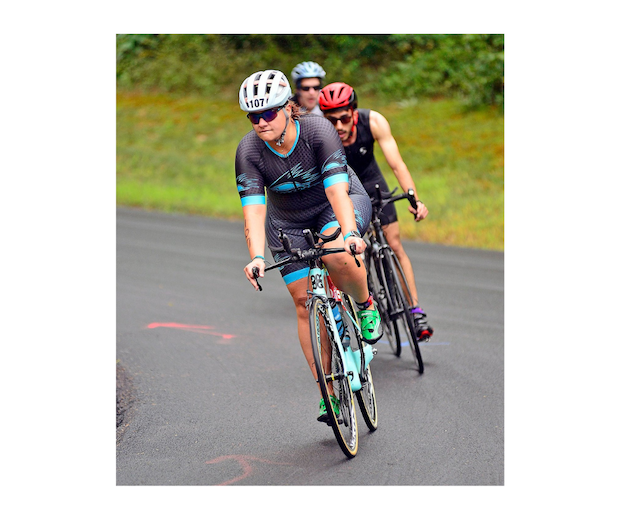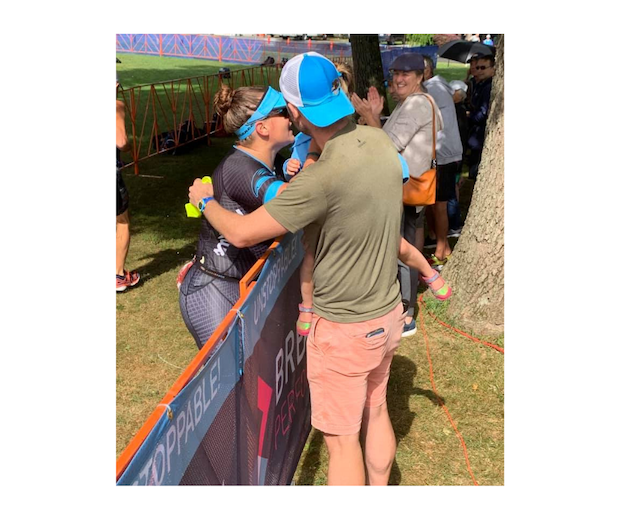What to Know About Athletes in Larger Bodies

As January turns into February resolution season is still going strong in my world. This is mostly reflected in social media and Google feeds which are dominated by advertisements selling me the promise of weight loss in every form imaginable. You name it, someone is trying to sell it. In most cases when I see these type of ads and report them as “misleading / scams” – because, well, most people who seek intentional weight loss fail. The resounding message from all of these advertisements is that you can’t be a real runner, a real triathlete, a real anything unless your body fits into a specific size range. This message is compounded by coaches (who make assumptions about athletes in larger bodies), race directors (who often don’t offer swag in extended sizes), and even the sport’s governing bodies. As an athlete in a larger body it is hard to see people and organizations you want to trust treat you like a second-class citizen.
Now before I go any farther, I’m sure there are readers out there saying “but it’s for your health” or “don’t glorify obesity.” Let’s get a few things straight — first and foremost, a larger body is a characteristic, not a behavior. There are plenty of people in large bodies who eat well and exercise regularly and people in smaller bodies who eat poorly and never exercise. The size of your body is not a proxy for health. A more effective determiner of health is whether or not an individual exercises.
Second many people have little or no control over the size of their bodies. This is especially true of people in larger bodies. Yes, there are people who make lifestyle choices that lead to having larger bodies. But lots of us, especially those participating in endurance sports, eat well and exercise frequently, and do not see any changes in our body size. You’ve probably met people like this at your last race. Just because you may have had success in manipulating your body size does not mean that all people are able to manipulate their body size. The behaviors you may have used to change the size of your body may or may not work for anyone else.
And lastly, dieting is not shown to actually improve health.

If we can accept that people in large bodies want (and in fact do) participate in endurance sports, there are things that coaches, race, directors, and other athletes should know about athletes in larger bodies.
A larger body does not make an athlete a beginner
This happens a lot. Someone sees a larger athlete at the gym, pool, or in a race and makes a comment like “if you keep it up it’ll get easier.” Or “just keep going and you’ll see how great this sport is.” Problem is for the recipient of the comment it may be their 100th time at the gym, they may have swum 500,000 yards this year, this may be their 25th race. Don’t assume that just because someone doesn’t “look” like your version of an athlete that they are just starting out in the sport. They may very well have (a lot) more experience than you.
Not all athletes in larger bodies are trying to lose weight
You've seen it, I've seen it; we've all seen it: the meme that shows a before of a large person starting their endurance sport journey and an after of a much smaller person often crossing a finish line at race. There are lots of people who start exercising with the intention of losing weight. There are also lots of people who enjoy moving their bodies and are not intentionally trying to lose weight. Weight loss is not the be all end all for athletes in larger bodies. Assuming that it is, or assuming that exercise leads to weight loss for all people is just plain wrong.
Representation matters
Seriously representation isn't just for Disney movies. It's important to see images that look like you to feel welcome and invited in any space. When a coach, or a race director, or a brand uses images that show the diversity of people and body types who engage in endurance sports that helps welcome more people to the sport. Its a lot easier seeing yourself doing something if there's an example for you to look at. Using only young(er), able bodied, lean people to promote the sport excludes a numerous portion of the population. What's even worse than excluding this population is only using this population as the "before" picture in the all too frequent "before and after" photos. This type of marketing is terrible not only because it promotes the idea that one body type is superior to another but also because it "[f]or every success story, there are hundreds, if not thousands, of regular people who end up demoralized — or, worse, with an eating disorder — after doing all the requisite work and failing to obtain the results they were promised."

Eating disorders exist in all body types
If you ask someone to describe what a person with an eating disorder looks like the description you will often get is a young, thin, white, cis gendered female. While teenage girls do indeed have eating disorders, eating disorders impact people in all types of bodies — even those in very large bodies. Unfortunately, many of us think that is someone's body is bigger there's no way they can be starving themselves. This is just not true. There's important work being done in this area, notably by Dr. Erin Harrop. I would strongly suggest listening to her on Maintenance Phase. Most importantly when someone tells you about their lived experience — believe them. Athletes in larger bodies are just as likely to have an eating disorder as athletes in smaller bodies.
Athletes in larger bodies use clothes and gear too
Those of us who are straight sized often forget or don't realize how hard it can be to fund functional performance gear if you are over a size 12 or 14. There are situations in which gear is simply unavailable in larger sizes (not for nothing while going to a size 2Xl may seem "generous" it still excludes many people). In 2020 Marielle Elizabeth wrote a fantastic article for The Cut detailing the struggles she had finding clothes in her size that were warm enough for winter sports. Her words on this are better than any I can write:
Whenever I speak up about size inclusivity, I get DMs insisting that I should just lose weight — as if clothing isn’t a need, but something to be earned. As if avoiding frostbite is a reward for thinness. My goodness, is there anything more crushing than the irony of criticizing the way larger bodies dress, all while knowing how painfully limited their choices are? So since every winter I find myself in this mess, let me say what all your fat friends are thinking: Clothing is a basic human right, and we are, quite literally, freezing out here.
Anti-Fat Bias is Real
Whenever I talk about things like anti-fat bias or thin privilege in the endurance sports space I get a lot of push back. I get it. It's hard to acknowledge that many of us, myself included, make assumptions and judgments about people in bodies larger than ours that are both hurtful and untrue. How many of us are guilty of thinking or saying "I may be fat, but at least I'm not as fat as X." Why is it that the most searing criticism we can make against a person we dislike is that they gained weight? Most of us grew up with this, saw this repeatedly modeled, and were taught that anti-fat bias is ok. There's a lot to grapple with and unlearn. But the place to start is to recognize that bias against fat people is real and that there are privileges associated with being thin (we can start with #5 above — thinner people can find clothes and gear that fit). If you're ready to do the work a great place to start is Aubrey Gordon's book, What We Don’t Talk About When We Talk About Fat. The next time your mind jumps to a conclusion about a larger athlete, pause and ask yourself whether your assumption is reality or whether bias is coming into play.
If you made it this far, there's a lot here to think about. This is an area in which it's easy to leave our biases and prejudices unchecked. But if we want to grow the sport, if we want to include more people, and get more people to stay, it's important to examine our biases about larger athletes and do the work to make everyone feel included in the endurance sport space.




Start the discussion at forum.slowtwitch.com